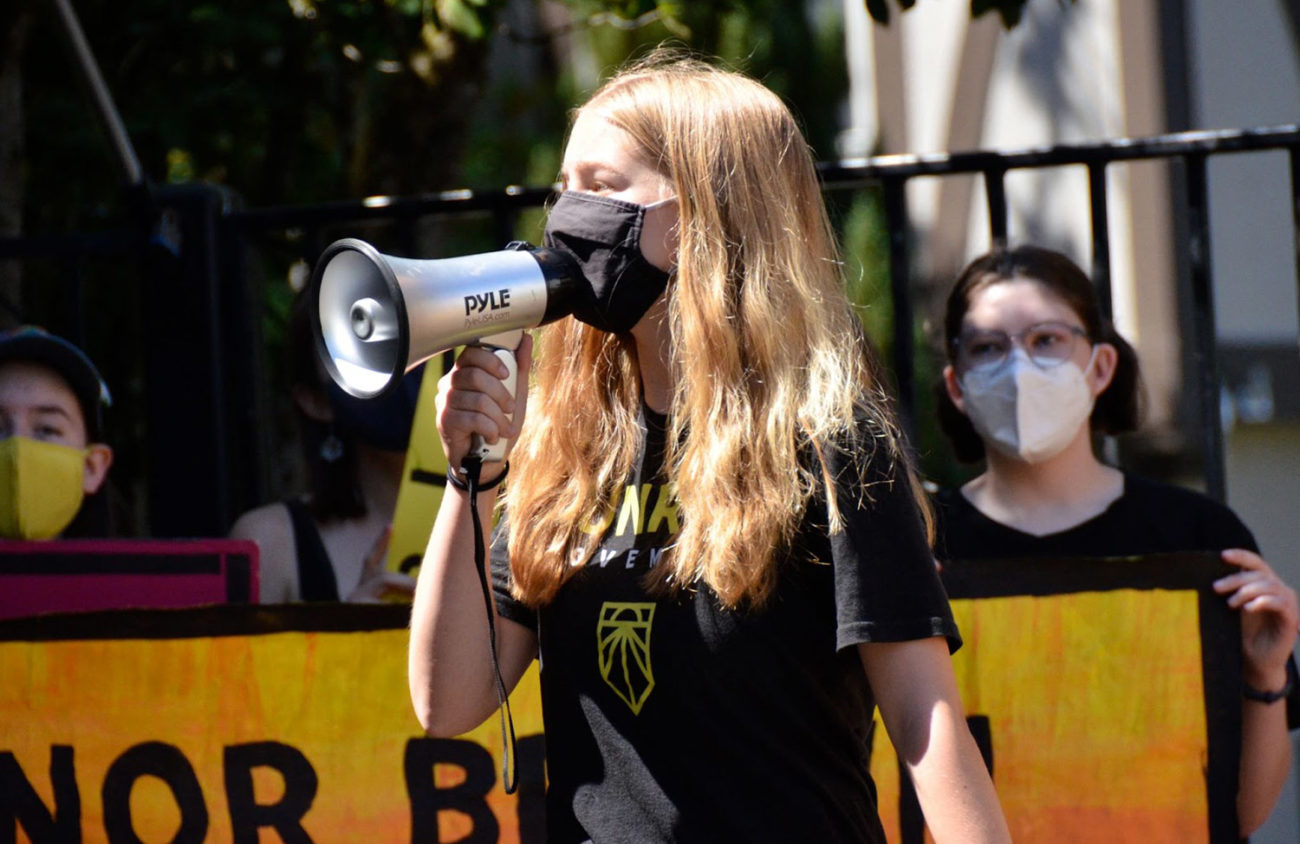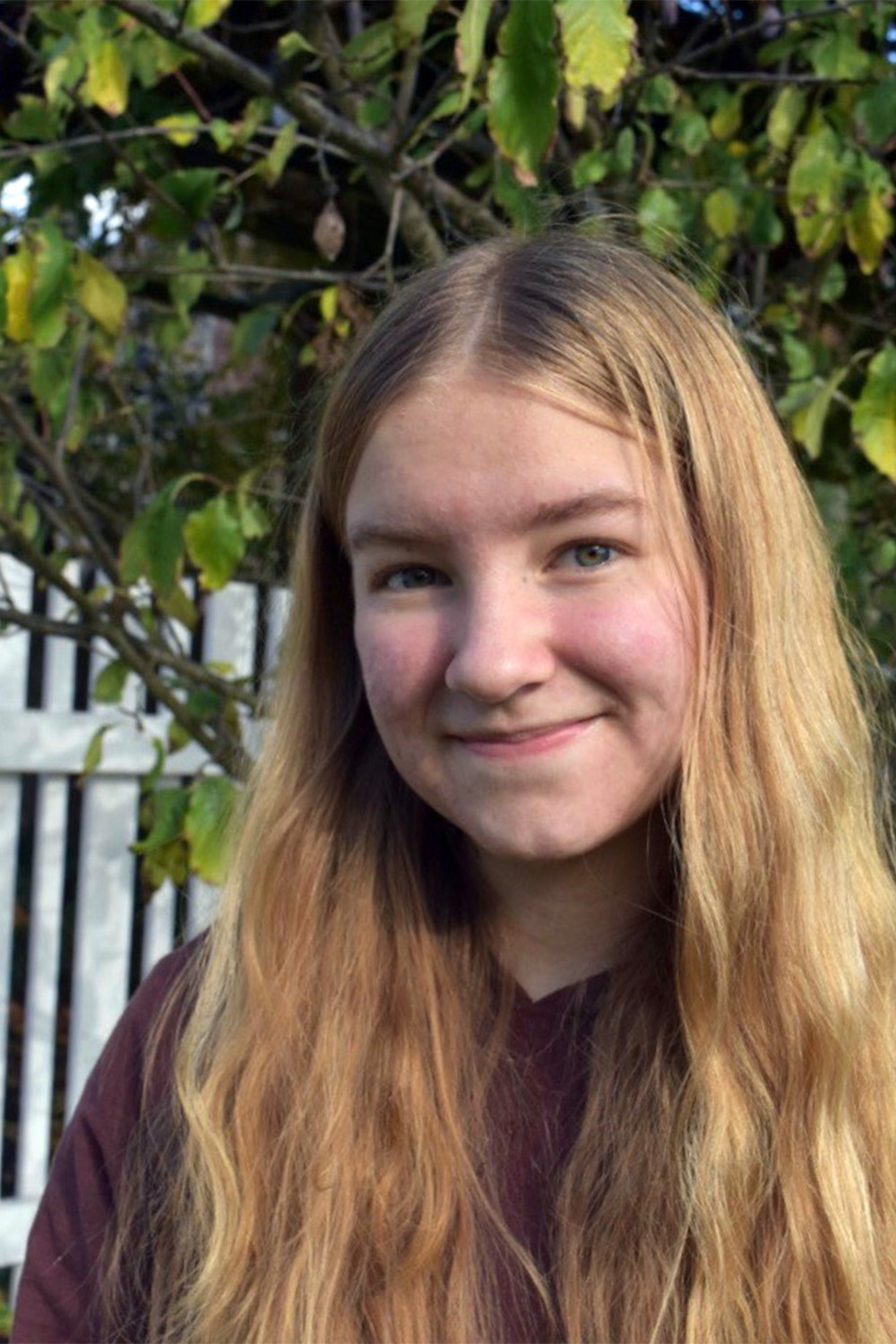Adah Crandall started her fight for climate justice after attending Harriet Tubman Middle School, which is bordered by I-5 and scheduled for relocation due to the freeway’s proposed expansion. She remembers learning about diesel pollution and seeing classmates afraid to go outside for fear of the toll it could take on their health.
Now, Crandall — a sophomore at Grant High School in Portland — is actively calling on Gov. Kate Brown to stick to her promise of climate justice and focus on the issue of transportation. Brown asked the Oregon Legislature to set aside $120 million to relocate the middle school earlier this year.
At 16, Crandall has been called the Greta Thunberg of Oregon, a comparison she is not fond of. Every other week, she gathers outside different government buildings in Portland with a group called Youth vs. ODOT and leads the demonstrators in chants as they call on elected officials to halt freeway expansion.
Crandall and other Sunrise PDX activists started Youth vs. ODOT in April 2021. What began as only a handful of demonstrators from Grant High School has since grown to a demonstration that has drawn more than 70 people from high schools and communities all around Portland.
The group has four demands: Put all the funds from the federal infrastructure bill towards projects that will reduce carbon emissions, appoint a youth climate advocate to the Oregon Transportation Commission, create an environmental impact statement on the Rose Quarter freeway expansion from ODOT, and place a moratorium on all freeway expansions within Portland’s urban growth boundary.
After almost a year of rallies, not one of these demands has been met, but that is not to say the group isn’t being heard. Crandall and other Sunrise members met with Brown in September, which “felt very legitimizing even though not much tangible action came out of the meeting,” Crandall says.
In this Q&A, Eugene Weekly and Catalyst Journalism Project reporter Nika Bartoo-Smith speaks with Crandall about climate justice, leadership failures and Crandall’s hope for the future. This interview has been edited for length and clarity.
What propelled you to where you are now, and do you remember a moment that solidified for you that your calling is to fight against climate change?
I don’t think there was one particular moment, but my experience at Tubman Middle School definitely informed the work that I am doing today because I could see and experience the firsthand impact of students breathing pollution and students getting hit by cars while walking and biking to school because there aren’t safe crosswalks. And so I think it was really just as I learned more and more about these issues, the more scared I became about the future, and the more motivation I had to take action.
How did your motivation for climate activism form into the action we see today with the bi-weekly protests?
Youth vs. ODOT was really born from a lot of different young people. Having different experiences either with transportation injustice or climate injustice, or both, and then coming together in a collective understanding that our transportation system needs to change.
Is fear one of the primary drivers for you in calling on everyone to pay attention to climate change?
Yes, but I also think that it is unsustainable for these movements to be built purely on fear. They also have to be built on hope for a better future. And we also need to be keeping in mind the better world that we are fighting for and not just the scary world that we are fighting against.
What does the better world you’re fighting for look like?
Teenagers wouldn’t have to worry about the climate crisis. Middle schoolers wouldn’t have to worry that the air they breathe is going to cause asthma or lung cancer. Buses that run every five minutes, so we don’t rely on freeways or cars.
What do you do to remain hopeful?
It’s hard, I’m not very good at being hopeful. I surround myself with a lot of people who are better at it than I am. A lot of people say that I am negative or pessimistic — I think that I am being realistic, because things really are pretty bad.
Will you expand on that and why you find it hard to have hope?
The climate movement is often very reactionary. It’s often about what we are fighting against, not what we are fighting for. So it’s hard to be hopeful as a young person who is watching wildfires and record-breaking heatwaves and snowstorms in April and to see that the people in power just keep going like everything is normal. That is terrifying — the idea that people don’t seem like they are panicking as much as they should be — which leads to feeling isolated and alone. So I do lean on other people for the feeling of hopefulness.
There is a lot of hope that comes from joining together and taking action, like the Youth vs. ODOT rallies that happen every other week. There are all of these people who are gathering together, fighting for the same things — we sing, we chant and it’s very unifying in a way that makes this movement really powerful.
Why do you think it is so important that youth are playing an active role in the fight against climate change?
It’s really as simple as the fact that people in power right now aren’t going to live to see the lasting impacts of their decisions. They are not acting with the future in mind. They don’t have the same stake in it as young people do. I think that as youth, we have the ability to understand all the stakes, and also more imagination to believe that a better world is possible. We have an ability to vocalize the radical changes that we need in a way that older generations often can’t.
How is climate change directly related to the Oregon Department of Transportation freeway expansions, and why did you choose this particular issue to focus on?
Forty percent of Oregon’s reported carbon emissions come from transportation, and those emissions aren’t coming from people who walk or bike — they are coming from cars and diesel trucks on giant polluting freeways that ODOT is trying to expand. So for me, it’s a combination of knowing that statistic, but also understanding the smaller scale impacts that freeways have on communities.
Where were you — both emotionally and physically — on election night when Kate Brown was re-elected?
In 2018, I was standing on stage behind Gov. Brown as she gave her victory speech. I wasn’t nearly as politically involved as I am now, but I was very excited to see a leader like Gov. Brown in office. I had a lot of hope for the future. She was a person that my peers and I were rallying behind. We were excited. And then she let us down.
What originally had you rallying behind her?
Gov. Brown made a lot of promises about fighting for the future, fighting for climate justice and fighting to better our communities. There’s this line in her victory speech, she was like, “We’re going to fight to protect our air and our water and our pristine coastline” or something like that. And she also talked a lot about education reform, which was something that was very important to students. In retrospect, I am able to understand that the things politicians say when they are running their campaigns are often for the purpose of getting them elected, and not necessarily because that’s what they are actually planning to do.
When did things change for you, Brown becoming someone you believed in to someone who “let you down”?
It was sort of a slow, over time thing. But it really became clear when I started organizing with the Youth vs. ODOT campaign and realizing that Gov. Brown was one of the people who was pretty directly standing in the way of meeting our demands. I hadn’t really had reason up until then to pay attention to what she was doing. But that came into stark focus when we realized that she was basically the most powerful person in the state and she was OKing all of these freeway expansions ODOT was proposing. That’s very contradictory to her supposed values of climate justice.
You have been compared to Greta Thunberg in the past, by news organizations and people I have talked to about your activism. What do you think about this comparison?
I don’t love it. I like that the comparison ties what we are doing to a global movement for climate justice, but I am my own person. In our society, the media often feels the need to find the “one perfect hero” — the climate movement has framed Thunberg as that person. The work that she is doing is great, but there are so many other people doing that work that don’t get nearly as much credit. I’m also not doing this work by myself. I would not have been able to do any of this work without the incredible team of people that I am working with.
What do you think is the most important thing that needs to be done to combat climate change?
To stop climate change, our entire society needs to change the way that we are thinking about these issues. And that is not a simple task. Climate justice work needs to be centered in all of the decisions that we are making, but also through an intersectional lens and understanding that it connects to all these other issues because if we section off climate change as its own issue, nothing is going to get solved.
Our society has a tendency to put things in boxes, and I think that’s a barrier to progress because that’s not how the world works. And so having a collective understanding both at a public level and an elected official level that climate change is basically connected to everything is the first step.
What gives you a sense of hope?
Knowing that I am not in this fight alone gives me a lot of hope. And knowing that even if we do lose, I will have learned so much and met so many incredible people. We try to find joy in the advocacy work that we are doing because if it’s constantly all serious and terrified urgency, then that’s not sustainable. At a logical level, I do have hope because I know that there are so many people fighting for climate justice.
What’s next for Youth vs. ODOT?
Youth vs. ODOT is coming up on our one-year birthday at the strike that is on April 27. It will be our 26th strike, which is wild to me. It’s been a year, and none of the elected officials have met any of our demands. But we are not going away. We are going to continue showing up. Because we have a bigger stake in this than our leaders do.
This story was developed as part of the Catalyst Journalism Project at the University of Oregon School of Journalism and Communication. Catalyst brings together investigative reporting and solutions journalism to spark action and response to Oregon’s most perplexing issues. To learn more visit CatalystJournalism.uoregon.edu or follow the project on Twitter @UO_catalyst.
This story has been updated.

